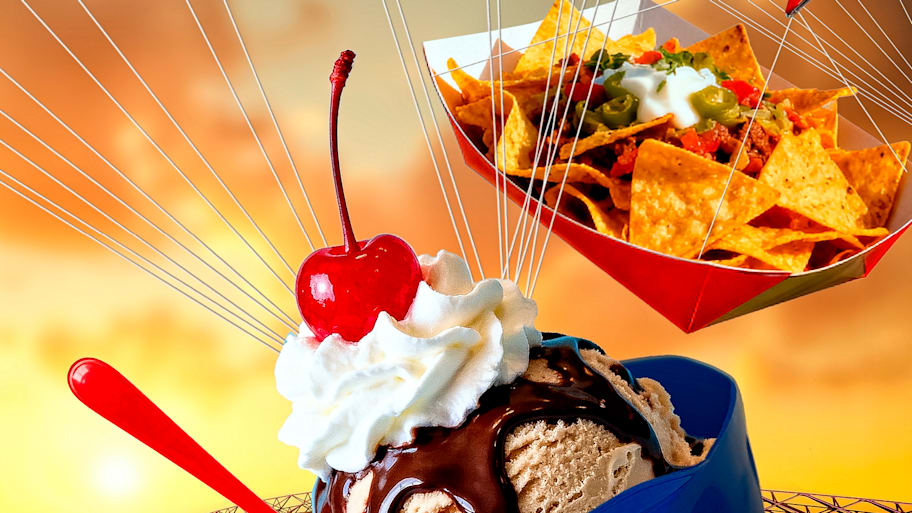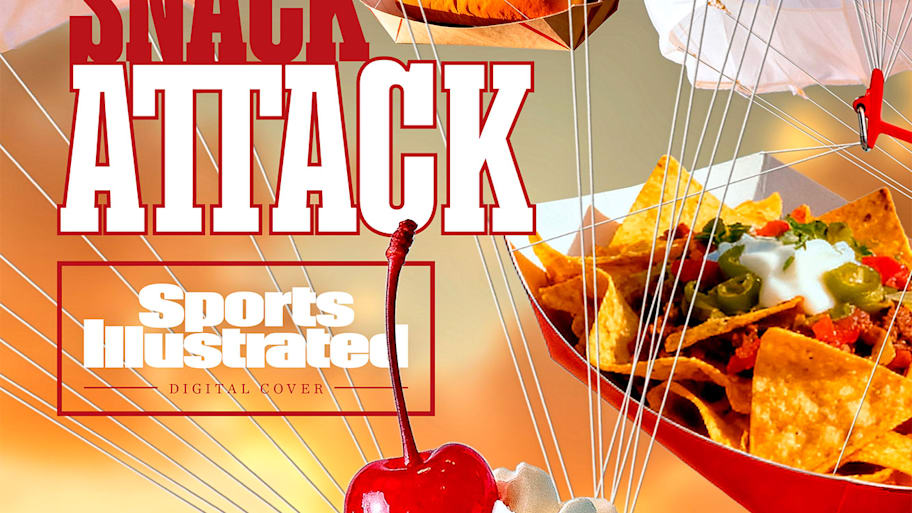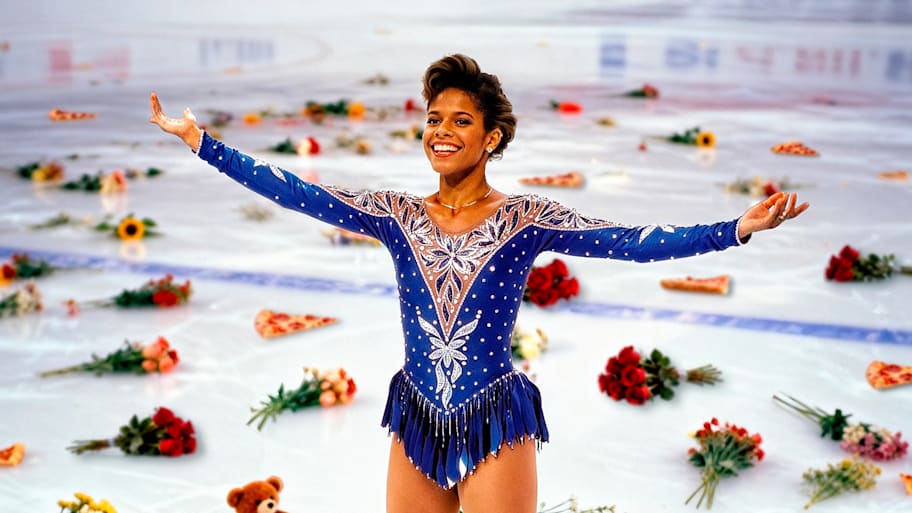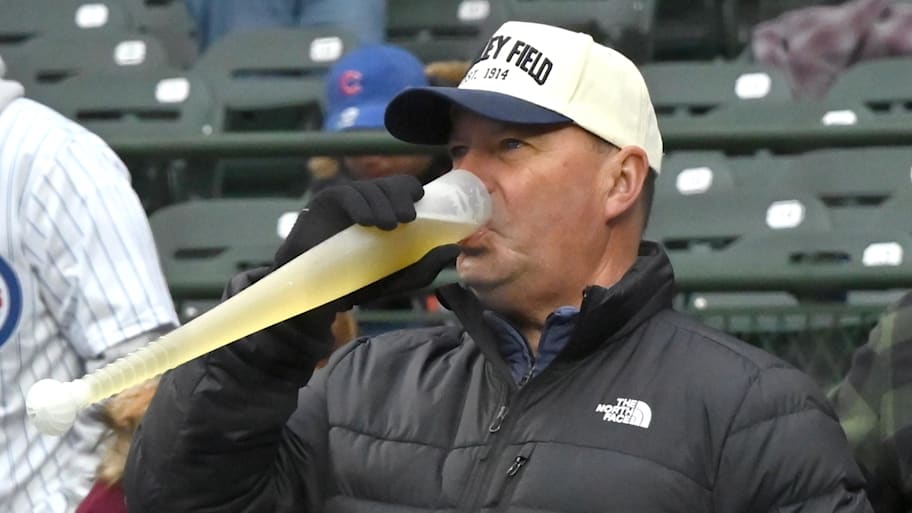
Behold the batting helmet sundae, striated coil of vanilla soft serve extruded into a plastic hat and stabbed, at point of purchase, with a spoon that stands on its own, like the ceremonial first shovel at some grand civic groundbreaking. It’s a Wednesday afternoon at Citi Field and cupped in your trembling hand is a miniature Mets batting helmet. Pasteurized, homogenized, romanticized, the helmet sundae is the sun-kissed marriage of Mr. Softee and Mrs. Met, food and baseball, a divine partnership. And what God has joined together, let no man tear asunder.
This is a love story about stadium food. Last spring, television cameras caught a couple at Wrigley Field Lady and the Tramp-ing a hot dog, attacking it simultaneously from either end until they eventually met in the middle for a kiss.
At the same park, in 2012, the center-field message board flashed a fifth-inning proposal: erica, will you marry me? Alas, Erica’s seat was empty. Only when she returned from her beer run, a cold one in either hand, was the message reposted while her suitor, Greg, took a knee, their relationship consecrated in two-fisted splendor.
America’s greatest living poet attended a Red Sox game with his daughter’s fiancé in 1928, and seemed to regret the road not taken. Robert Frost left Fenway feeling slightly emasculated after being outeaten by his future son-in-law, James Dwight Francis. “I had a fine time at the ballgame with Dwight,” Frost wrote to his daughter Lesley after watching the Sox and Senators split a doubleheader that August. “I didn’t quite hold my own on the peanuts and hot dogs. Another time, I’ll go prepared to eat everything.”
Ninety-seven years later, those last five words remain good advice. Ballpark food is equal parts gluttony and poetry.
Dippin’ Dots, tater tots,
Chicken wings, onion rings.
That’s just one inning at a Rockies game. Eating a sundae from a Mets hat in Flushing, with blue and orange sprinkles forming a lurid simulacrum of sky and sun, a baseball fan is in want of nothing. Until he hears the distant cry of a vendor, calling across the concourse but also echoing across the ages, declaiming another rhymed couplet: “Beer here!”
We’ve been eating food at stadiums for millennia
Human beings have always required sustenance in stadiums. Ancient Romans ate figs, dates, olives and plums while watching gladiatorial combat, according to a 2022 study of the sewers surrounding the Colosseum. Twentieth-century yinzers enjoyed bottled beer, bottled gin and “orange drink” while attending Pirates games, according to a 1970 study by the Mets’ right fielder Ron Swoboda of objects thrown at him by fans at Forbes Field. The beer and booze bottles narrowly missed him, but an orange drink carton hit Swoboda in the head. “It looked like a fruit store,” he said of the outfield grass, littered in produce.
The stadium food porn that litters Instagram in the 21st century caters to foodies—literally so, if you’re ensconced in a suite, dining on penne alla vodka from a stainless-steel roll-top chafer. Esoteric concession stand offerings are often difficult to decipher without a scorecard—Rocky Mountain oysters are testicles, octopus balls are not—but many fans repudiate popcorn and hot dogs for fine dining. Paul McCartney was once fork-fed ravioli off a china plate by his wife in the front row at Yankee Stadium, as if to say: Working on peanuts is all very fine, but I can show you a better time.

And good for the gastronomes. But sports fans of a certain age and temperament, the kind who read gastronome but hear Astrodome, know the stadium foods that truly connect us—across time and continents—are the humble staples of the cheap seats: fan fare for the common man.
In 1999, a soccer referee named Paul Durkin, officiating the FA Cup match between Chelsea and Oldham in England, was struck from behind by an airborne projectile. He felt the nape of his neck, withdrew his hand and beheld a crimson palm.
“I had a brief moment of panic,” he said afterward, “because I was covered in tomato ketchup and I thought it was blood.” He’d been hit by the fundamental building block of stadium food everywhere: a hot dog, or sausage roll, or other form of cylindrical meat, grilled, boiled or steamed, and then bunned.
Humphrey Bogart once said, “A hot dog at the game beats roast beef at the Ritz,” but a hot dog at the game beats everything. Before Game 1 of the 1956 World Series opener in Brooklyn between the Dodgers and the Yankees, the producers of the television quiz show I’ve Got a Secret conceived a gag. They would have movie star Paul Newman, dressed as an Ebbets Field vendor, surprise one of the show’s regular panelists, the humorist Henry Morgan, by selling him a hot dog at his seat.
A Sports Illustrated photographer was assigned to capture the moment on film.
Alas, before Newman could get anywhere near Morgan, he was set upon by ravenous Dodgers fans. “I was just swarmed by a pack of hungry rats,” he explained. “This one guy kicked me and said, ‘Six please!’ So I started handing out hot dogs. I sold one whole tray of these things and had to go back for the second one, and by this time, someone had given [Morgan] a hot dog already … It’s very nerve-racking. It’s sort of survival of the fittest.”
Several fans asked Newman, then starring as boxer Rocky Graziano in the MGM biopic Somebody Up There Likes Me, where the nearest bathroom was. At the ballpark, he was not a Hollywood celebrity but a mere conduit to fans who wanted to eat hot dogs and void their bladders of beer. In 30 minutes, Newman sold $26 worth of meat, earning 20 cents a sale, and took home $2.60.
He didn’t know where the bathrooms were.
Sometimes, the grub makes its way to the field—and on the athletes, too
Nine years earlier, in the same park, on the brisk April day that Jackie Robinson broke the color barrier in Major League Baseball, Rachel Robinson fed the couple’s 17-month-old son, Jackie Jr., a bottle warmed by a thoughtful concession stand worker, who immersed it in the hot water used to keep the red hots from going cold. Mrs. Robinson would return to that stand, to warm a bottle, for several years, at a time when baseball and hot dogs were perhaps the two most potent symbols of American ingenuity.
At the height of the Space Race, Soviet premier Nikita Khrushchev toured a meatpacking plant in Des Moines, where he ate his first American hot dog. Khrushchev lamented that while the Russians had beaten the U.S. to space, the Americans had clearly beaten Russia in the art of sausage making. Khrushchev’s counterpart, President John F. Kennedy, was scheduled to throw out the first pitch on Opening Day of 1963 for the Washington Senators while members of the stadium workers’ union were picketing outside D.C. Stadium, pleading with fans to abstain in solidarity. “Please do not buy sodas, beer, peanuts, popcorn, hot dogs, hamburgers, scorecards, novelties or any other items sold in this stadium,” their handbills urged. U.S. labor secretary W. Willard Wirtz interceded, scheduling urgent negotiations for the next week. Only then could President Kennedy, in good conscience, eat a hot dog in his box seat.
This summer, concession workers in Boston picketed before a Dodgers-Red Sox game. They sought higher wages while urging fans to patronize the street vendors outside the ballpark, a recognition that not eating at Fenway is not really an option, a (Butch) Hobson’s choice.
Eating hot dogs at games is a right, but also a franking privilege that is sometimes abused. Packers wide receiver Randall Cobb, after scoring a touchdown in Green Bay in 2014, Lambeau Leapt into a crowd of fans wearing polystyrene cheddar wedges before emerging from the mob covered in ketchup. “I apologize to whoever’s hot dog that was,” Cobb said, when it should have been the fan apologizing to him—to all of us—for putting ketchup on a hot dog.

Every so often, as Cobb can attest, athletes and stadium food collide. Shortstop Orlando Arcia, then with the Brewers, once chased a foul ball into the stands in Milwaukee and helped himself to a spoonful of batting-helmet soft serve from an unsuspecting fan in the front row. Yankees first baseman Don Mattingly memorably tracked a foul ball to the railing in New York and grabbed a piece of popcorn from the carton of a wonderstruck young fan. After futilely pursuing a foul ball in Detroit, Tigers first baseman Prince Fielder filched a man’s nacho as a consolation prize.
In 1933, a Senators fan threw a hot dog at Yankees outfielder Ben Chapman, who provocatively picked it off the Griffith Park sod and ate it, at which time, in that last summer of Prohibition, he was showered with glass soda bottles. Food has always been used as a weapon in stadiums, where we remove our caps for the national anthem and have our bottle caps removed for us, at the concession stand, lest that Pepsi bottle be used to brain a center fielder.
World-class athletes are not immune to the siren song of stadium food. A few years ago the Braves had a soft-serve machine in their clubhouse, replete with mini helmets, so that the Atlanta players could, in theory, eat sundaes out of Braves batting helmets while wearing Braves batting helmets.
Olympic figure skater Debi Thomas, accustomed to fans throwing flowers at her feet at the end of every routine, said that she’d prefer it if they threw pizza instead.

At spring training in 1982, Cubs reliever Rawly Eastwick was watching a game from the stands when he choked on a hot dog and was Heimliched by the team trainer. Eastwick then did what any of us would do: He took another bite of the hot dog, with similar results. This time he was rushed to a nearby hospital, where the cylindrical meat was removed from his upper esophagus with a bronchoscope.
During most games, however, there is a bright line dividing fans and players: one eats, the other competes. Even in an era when fans wear caps and jerseys to games, as if they might be summoned to pinch hit at a moment’s notice, it is seldom difficult to tell the fans from the athletes.
“I remember when you used to be good,” a heckler said to Reds first baseman Joey Votto in 2017, to which Votto replied: “I remember when you used to be thin.”
Beer has become synonymous with watching sports
In fairness, it has never been easy to be thin in Cincinnati, where the bleachers at old Crosley Field were known—in longtime announcer Waite Hoyt’s home run calls—as Burgerville. “He hit it into Burgerville!” was a sponsored shout-out to Burger beer, even though its pitchman was a recovering alcoholic. In 1945, before he joined Alcoholics Anonymous and enjoyed 40 years of sobriety, Hoyt went on a three-day bender that left him AWOL from Reds’ broadcasts, an absence the newspapers attributed to amnesia.
Babe Ruth, his former teammate and drinking buddy, knew better. “I heard you got a case of amnesia,” he telegrammed Hoyt. “Never heard of that brand.”

Beer is to spectator sports what seawater is to shipbuilding, a perpetually replenished ocean that keeps a vast enterprise afloat. There are nearly 100 brews to choose from at White Sox home games, but craft beer’s esoteric names—Sex & Candy; Sticky Nuts; Furious George—don’t neatly lend themselves to home run calls. In another century, Mel Allen referred to Yankees home runs as “Ballantine blasts,” but in 2025, in the South Bronx, the alcoholic beverages are self-aware. Fans can avail themselves of a Two-Rum Home Run, Gold Glove Sour or Ginfielder, though not—or at least not yet—Babe Ruth’s Called Shot.
Local food, and flair, make for the best treat
The best fan food is local, where the venue and the menu are indivisible. I have personally enjoyed a pimento cheese sandwich at the Masters, a mint julep at the Kentucky Derby and strawberries and cream at Wimbledon, but I have never enjoyed any of these outside their natural habitats.
In rainy Seattle, there are scattered showers of sausage. The Mariners tether hot dogs in foil sleeves to parachutes. The dogs are dropped from the upper decks of T-Mobile Park into crowds of upstretched arms, seekers straining toward some higher power. “Hot Dogs from Heaven,” as the promotion is known, forms a strangely touching tableau: part Allied paratroopers alighting in the D-Day drop zone, part when-pigs-fly whimsy.
In Philadelphia, a city more synonymous with blunt-force trauma, the Phillie Phanatic strafes fans with point-blank rounds of lukewarm sausage fired from a hot dog cannon.
Each city has its own food rituals, but so does every individual fan. Perhaps you take a highway maintenance man’s pride in yellow-striping a hot dog, straight down the middle, at a ballpark mustard pump. You probably have a kitchen cabinet full of stacked souvenir beer cups from stadiums around the world, their colors faded from the depredations of the dishwasher. For a while, I saved the empty La Nova pizza box that served as a warm, dry seat cushion on a snowy day at a Bills game in Buffalo.
Anything object can be fetishized in this way. I once opened a file folder marked “Ballpark Food” in the research library of the Baseball Hall of Fame in Cooperstown and—while riffling through newspaper clippings and Xeroxed concession menus—watched a 30-year-old foil hot dog wrapper from Shea Stadium fall out. “I’ll take that,” said a white-gloved curator, plucking the wrapper from my carrel before—I hope—slabbing it in Lucite like a gem mint 1956 Mantle.
Ed Glynn was a Shea Stadium hot dog vendor as a high school student in Flushing before becoming a Mets pitcher in 1979. The team would later present their reliever with a hot dog vendor’s case with his No. 48 on it. At Shea’s successor, Citi Field, Glynn’s successors still sell hot dogs on a Wednesday afternoon, roaming the stands as Paul Newman did in neighboring Brooklyn, where the Nathan’s frank was born in 1916. A hundred and nine years later, that hot dog still holds up at the ballpark.
Gaze upon the Nathan’s frank, recumbent in its cardboard casket, whose open lid holds a packet of mustard. Tear it open with your teeth and apply its contents with the precision of a pastry chef icing an éclair.
It was here, in New York City, that Harry M. Stevens first married food and fandom on a mass scale. Stevens emigrated from England to Ohio as a teen in 1882, labored as an ironworker, invented the baseball scorecard, but moved to New York and made his fortune selling hot dogs, popcorn and peanuts to fans at Madison Square Garden and the Polo Grounds. “It is believed that Mr. Stevens feeds more gaping human mouths in one day than any other individual in the world,” Damon Runyon, the baseball writer turned playwright-novelist, wrote in 1929. “After thirty-five years of stuffing hot dogs, peanuts and ham sandwiches down the gullet of the baseball bug, and the racing nut, Mr. Stevens has so much money that he no longer counts it. He weighs it.”
Stevens died in 1934, reportedly of arteriosclerosis, though his demise has since been attributed to pneumonia, confirming what many have long suspected: No food can have a deleterious effect on one’s health as long as it’s eaten at a live sporting event.
Nachos reign supreme
Cubs shortstop Addison Russell, going into the front row to snag a foul ball in St. Louis in 2017, collided with a fan eating nachos. The chips, as chips do, fell where they may. “I got all nacho’d up,” said Russell, who as a goodwill gesture between innings presented the fan with a fresh order. As he explained later: “You don’t get in [between] a man and his nachos.”
You don’t. Lakers guard Magic Johnson reduced his body fat from 14% to 4% in a single offseason in large part by eliminating his favorite arena food. “I love nachos,” he said at the time. “I’d have nachos five nights out of seven, at least.”
Nachos are almost entirely a sports-created phenomenon. They were the invention of a maître d’ at El Moderno restaurant in Piedras Negras, Mexico, across the Rio Grande from Eagle Pass, Texas. Though Ignacio “Nacho” Anaya first loosed them on his grateful patrons during World War II, they weren’t mainstreamed in America until 1976, when the Rangers introduced them at Arlington Stadium. The club sold 250,000 orders that season, instantly eclipsing hot dog sales.
Fifty years later, they remain irresistible. “Isn’t it strange that we’re waiting in line to spend 30 f---ing dollars on nachos?” says a happily inebriated man in a vintage Jacob deGrom Mets jersey to the 20 strangers queued in front of him at the Goya stand down the third baseline on the Citi Field concourse. “Nachos, dude.”
The nachos grande are actually $17.89 plus tax, a price commensurate with the joy of eating them from a replica Mets batting helmet the size of a human head. Farther along the concourse, in the Citi Field memorabilia shop, a batting helmet worn by Mets second baseman Jeff “The Squirrel” McNeil in a game against the Brewers will set you back $1,000. And it is not filled with chips, cheese, sour cream and shredded chicken.
Those of us who gorge on food and drink in Flushing Meadows divide our day between the restrooms and the field, between Flushing and Meadow. All these nachos grande and 32-ounce sodas have to go somewhere. Life’s arc—we eat food, then we are food—is condensed into three hours. After 10 innings of gorging—the Mets won—the baseball fan is stadium food. We traverse the bowels of the stadium, egress through the aptly named vomitoria, then inch our way into the clogged artery of the Whitestone Expressway.
On the shotgun seat, an empty ice cream helmet sits inside the empty nacho helmet, like nesting dolls. There is a third, invisible hat in the car. It is a golden sombrero, awarded to Mets center fielder Tyrone Taylor, who struck out four times in four at-bats, every one of them heralded by his walk-up song, still resounding in my ears and infiltrating my own clogged arteries: “It Was a Good Day.”
Five famous stadium foods
Secret stadium sauce
To quote Homer Simpson: It looks like ketchup, it tastes like ketchup, but brother, it ain’t ketchup. Baseball’s best condiment has got mustard and barbecue sauce notes, and Brewers fans slather it on all manner of sausages. In the 1980s, NBC’s Bob Costas and Tony Kubek would take turns broadcasting solo so the other could enjoy an SSS-slathered brat.
Duke’s Mayonnaise (on anything)
The eponymous condiment is everywhere at the Duke’s Mayo Bowl in Charlotte. The winning coach gets doused in it. More interesting, though, are the homemade concoctions ESPN broadcasters have come up with in the booth and eaten on air in recent years. It started with an Oreo dipped in Duke’s, then got all haute cuisine: a mayo-doused French macaron.
Jackalope Mac Stack
Jackalope is notoriously hard to find at a supermarket, mostly because it’s a mythical creature: a jackrabbit with antelope horns. So the Denver Broncos improvised, making a sausage out of antelope and rabbit (with some pork thrown in). Toss in some Flaming Cheeto dust (shockingly not mythical), some mac and cheese and you’ve got a meal that is, like its namesake, legendary.
Land of 10,000 calories
Leave it to the Veeck family’s St. Paul Saints (a Triple A team that has a pig named the Great Fatsby deliver balls to the umpire) to come up with this: a single, six-foot long hot dog topped with pulled pork, mac and cheese, fries and jalapeños. It comes with four drinks, a (hopefully unnecessary) reminder that it’s not meant to be taken down solo. The cost: $135, and probably a bit of your dignity.
Toasted grasshoppers
When the Mariners introduced chapulines—otherwise known as fried grasshoppers— in 2017, they ordered 20 pounds of the insects, thinking that would last them well into the season. They sold out on Opening Day. Fans started lining up before the first pitch to get their fix. Dusted with chili-lime salt, the buggers are a high-protein, no-carb option and a great Instagrammable treat.
This article was originally published on www.si.com as Eating at the Ballpark Has Never Been Better, or More Gluttonous.







